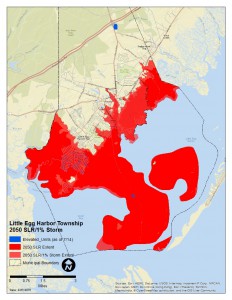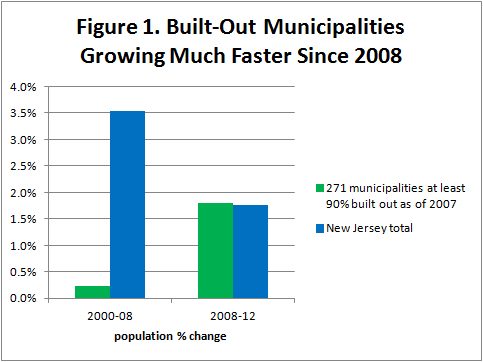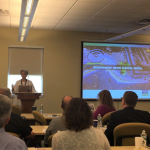New Jersey Future Blog
Planning Our Coastal Future: Little Egg Harbor and Tuckerton
April 28th, 2015 by David Kutner

Little Egg Harbor and Tuckerton: Projected inundation from sea-level rise and a Sandy-intensity storm in 2050. (Click on image for larger view)
At the first of a series of three public meetings, residents of Little Egg Harbor Township and Tuckerton Borough got an initial look at the results of an assessment of each community’s vulnerability to future flooding due to sea-level rise and potential storms. New Jersey Future prepared the assessments for the two communities.
New Jersey Future has been working with Little Egg Harbor and Tuckerton since Hurricane Sandy on storm and flood resiliency initiatives, helping community leaders understand future flooding risks they are likely to face. The detailed risk analysis evaluated where the towns are most vulnerable to flooding, and explored strategies to help them respond more effectively to future storms and rising sea levels.
An interactive poll conducted during the meeting revealed that more than 60 percent of those present experience flooding in their neighborhoods “frequently,” not just during extreme storm events. David Kutner, who manages New Jersey Future’s Local Recovery Planning Manager program, pointed out that flood risks are likely to increase in severity, making thoughtful planning and preparation essential in order to minimize or avoid the type of devastation caused by Hurricane Sandy.
Kutner said that immediately after Sandy municipal officials were focused on rebuilding as quickly as possible, returning residents back to their homes, reopening businesses and clearing debris. However, he said, with 11 federally-declared flood-related disasters in the past 12 years, municipalities need to plan proactively for the real possibility of future flooding events. More than 60 percent of audience members indicated in the poll that they believed climate change and sea-level rise are occurring and they want to be prepared.
The vulnerability analysis evaluates the impacts of sea-level rise in the year 2050, based on a report from Rutgers University’s Department of Earth and Planetary Sciences, which predicts an increase of 1.5 feet from today’s levels. Using a series of maps, Kutner showed that with this increase in sea levels, 31 percent of Little Egg Harbor, encompassing 1,032 lots or 9,085 acres, and more than 55 percent of Tuckerton’s area, covering 620 lots and 1,131 acres, would be inundated by 2050.
Showing a second series of maps, Kutner indicated that by 2050 a Sandy-type storm on top of sea-level rise would result in inundation of 4,711 lots in Little Egg Harbor, or 9,909 acres, 34 percent of the total area of the township. In Tuckerton, this 2050 storm would expose 1,219 lots or 66 percent and 1,357 acres of the borough.
Kutner noted that rising sea levels will also inundate the marshes that currently protect the borough and township. These marshlands cannot tolerate permanent inundation and if left unprotected will convert to open water. Under projected 2050 conditions the towns would lose their first line of defense against storm surge and wave action.
Kutner stressed that the results of the vulnerability analysis are only likely if no actions are taken to minimize future risks.
Leah Yasenchak, New Jersey Future’s local recovery planning manager working in both towns, then described projects that are currently being planned to attempt to address sea-level rise. One project involves spreading a thin layer of sediment over the marsh in a process called thin-layer deposition. This project is intended to help build up the marshes to keep pace with sea-level rise. New Jersey Future has secured a highly competitive $2.13-million dollar grant from the National Fish and Wildlife Foundation to restore several acres of marsh using this thin-layer deposition technique. New Jersey Future has also obtained funding so the Barnegat Bay Partnership can conduct the five years of monitoring required by the New Jersey Department of Environmental Protection as a prerequisite to permitting the project.
Yasenchak indicated that the NFWF project scope also includes dredging some of the township’s lagoons, with the intent to use the dredged materials both for the thin-layer deposition project and for replenishment of severely eroded areas of the Green Street Beach in Tuckerton. A living-shoreline project is also included in the NFWF scope, with Iowa Court in Little Egg Harbor a likely location for this work. This project would use whelks or clamshells bundled in wire cages to buffer wave action, and would then backfill the area with sediment and plant it with marsh grass to promote natural re-vegetation.
New Jersey Future will also help Little Egg Harbor and Tuckerton to become certified under the National Flood Insurance Program’s Community Rating System. Ranking under this system is tied to different steps the towns can take to protect the community from flooding, and participation can help reduce homeowners’ flood insurance costs.
New Jersey Future will conduct two more public meetings in the “Planning for Our Coastal Future” series: Tuesday, May 12, from 7:30 to 9:30 p.m., and Saturday, June 20, from 11 a.m. to 1 p.m., both in the Little Egg Harbor Community Center.
New Jersey Future received funding from the Merck Foundation and the New Jersey Recovery Fund to support three local recovery planning managers that have been embedded in six communities – two in Monmouth County, two in Cumberland County and two in Ocean County – that were severely damaged by Hurricane Sandy. The LRPMs perform as adjunct staff, working directly with the municipal staff to provide much-needed additional capacity to plan and implement projects to address immediate recovery, mitigate future risks and foster resiliency.

















The question is, WHEN. When will the towns start the dredging? Tuckerton has been saying they will dredg the lagoons for the past 10 YEARS!!!!!!!WE have a house on Kingfisher, in Tuckerton that we are re-building, , which at times is only 1 Ft. deep,and at the present time, I have to wait for mid-tide to get out to the bay. Yes, we have a house on the “water” and pay more taxes, which is only right, BUT we can’t use the waterways when we want to.